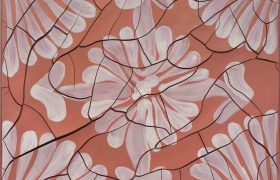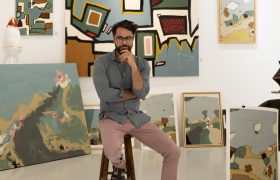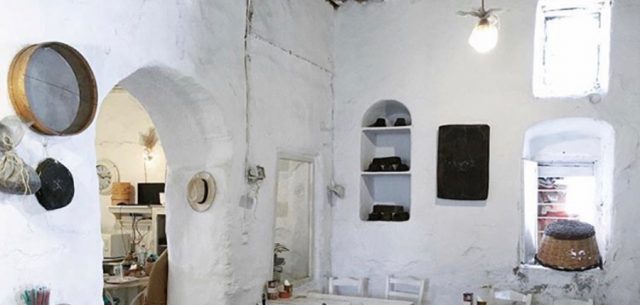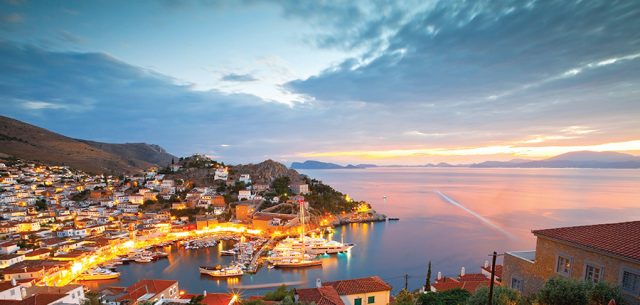Hydra’s lasting charm as an artist’s magnet
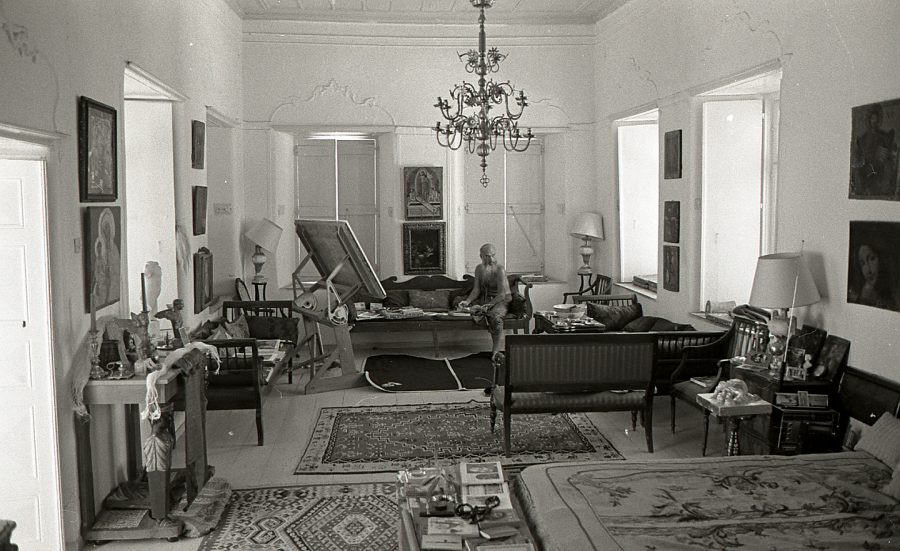
Yannis Kardamatis in his homme Hydra 86, Photo: Bjørn Saastad
Art historian Els Hanappe researches into the making of an international artists’ community on the island of Hydra during mid-20th Century.
Hydra 1936. Crumbling stone mansions testify to the glorious seafaring past of this long, bare and rocky island, close to Athens and across from the mainland of the Peloponnese. Less popular than its Saronic sister islands, Aegina, Poros and Spetses, its dwindling population struggles to make ends meet and its men travel to the coasts of North-Africa to scrape a living by diving for sponges. The main town of the island, eponymously called Hydra or Hydra town, is interspersed by open spaces, gardens and ruins between the traditional white houses. In the picturesque bay-shaped harbour a few fishing boats are moored and donkeys, the only means of transport over land, bray out over the sea toward the horizon. Natural sources are sparse as is produce from the land: olives, honey, resin, eggs. Water supply is limited. Evenings are spent dancing and drinking at the few local tavernas where wine flows from the goatskins and barrels. Returning sponge divers and local fishermen are joined by the cadets from the National Merchant Marine Academy that started operating in 1749. Life is uncomplicated, poor and quiet, with few people living side by side with nature.
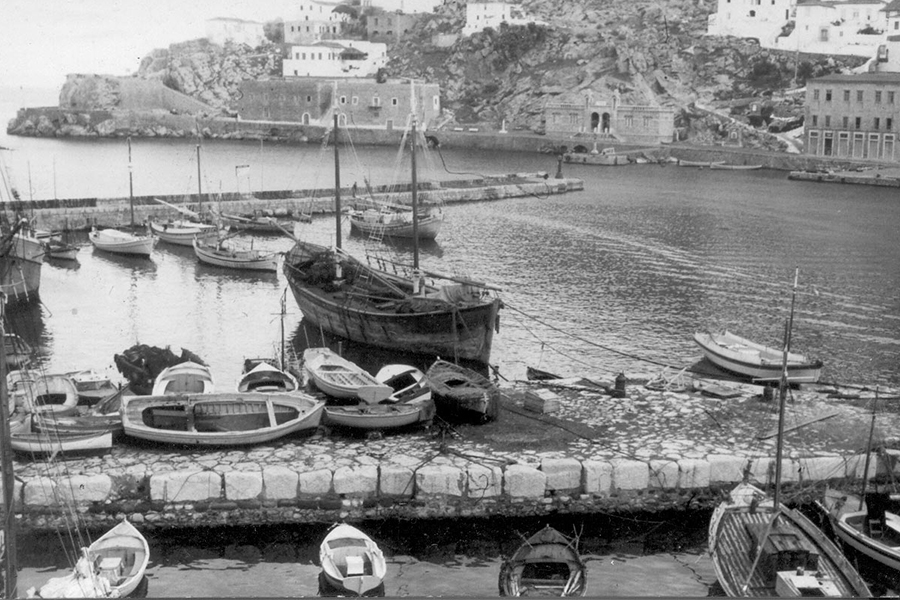
That same year, artist Nikos Hadjikyriakos-Ghikas arrives on Hydra, full of childhood memories of summers spent at his maternal home in the small neighboring fishing village of Kamini. Captivated by the familiar sounds and smells, by a world of senses, he restores the large mansion, the former seat of the shipping family whose days go back to the early 16th century. Only during the 17th century does the exiled population slowly move down toward the seashore to make a first modest attempt at ship building, which allows it to trade with other cities and countries. The enterprise flourishes thanks to the progressive economic system of cost-and-risk sharing. The Hydra fleet becomes so powerful that it plays a major role in the War of Independence from Ottoman rule in 1821.
Athens 1936. In the offices of the Athens School of Fine Arts in the Averoff building, recently appointed director Konstantinos Dimitriadis meets with artist Periklis Vyzantios to discuss the latter’s idea of opening up school branches across the country where students can stay at low cost, have access to studios and topical landscapes. Eyes are set on Delphi, Mykonos and on Hydra; the acquisition of the Tombazis mansion, an imposing stone building on the right side of the port, is negotiated. Periklis Vyzantios becomes the director of both the Delphi and Hydra branches and from 1945, of Hydra only. Both Ghikas and he promote the island to friends and visitors, urging them to buy the cheap houses before they disappear, to preserve the residential ambience of the island. Ghikas, who has fully restored his own mansion, receives in 1939 the acclaimed American author, Henry Miller, who will eternalize Hydra for his many readers in his memoir The Colossus of Marousi. The succession of two world wars has marked a whole generation who grew up with a feeling of constant threat, loss, pain, and disillusionment. It is a generation that longs for peace through mutual cultural understanding, freedom of movement and spiritual enlightenment. Young people from all over the western world flock together to experiment with alternative lifestyles in defiance of their parents’ bourgeois stifled attitudes. They spread out over continents, not to colonize but to learn, taking an interest in different cultures and religions. Some search for a simpler, more authentic life, others escape conventions and expectations. The world is on the move.
In Reims, Christian Heidsieck, eldest son that inherited the Charles Heidsieck Company, decides at age nineteen to leave the hometown seat of his family, and to forsake his place at the helm of the company for an unknown future and career in pottery making. He travels to France and Italy to train in the local techniques of faience and majolica. He arrives in Athens in 1948 where he takes up further training at the Kerameikos, Amarousi and Lavrio workshops and factories. He meets his future wife, Lily Mack, and the young couple opts for the simple, quiet life of Hydra where Christian, with the help of a local neighbour, builds a kiln. For the next few years the YDRA pottery produces unique pieces of heavy sculpted earthenware, hand-modelled, incised, and decorated in relief, all of which successfully sell locally.
From the mid-Fifties, a new nucleus forms around the charming literary couple, George Johnston and Charmian Clift, who take up residence on the island. Artist Sidney Nolan visits his fellow Australian expats from London and rents part of the Ghikas house where he stays with this wife Cynthia. American artist Timothy Hennessy is a guest of Ghikas in 1957 and buys his own mansion on the island, which he later shares with his artist friend, Ioannis Kardamatis. Word and fame spread. Hydra forms the setting for popular Greek and international movies, celebrities mingle with the locals and Hydra is established as a hot spot.
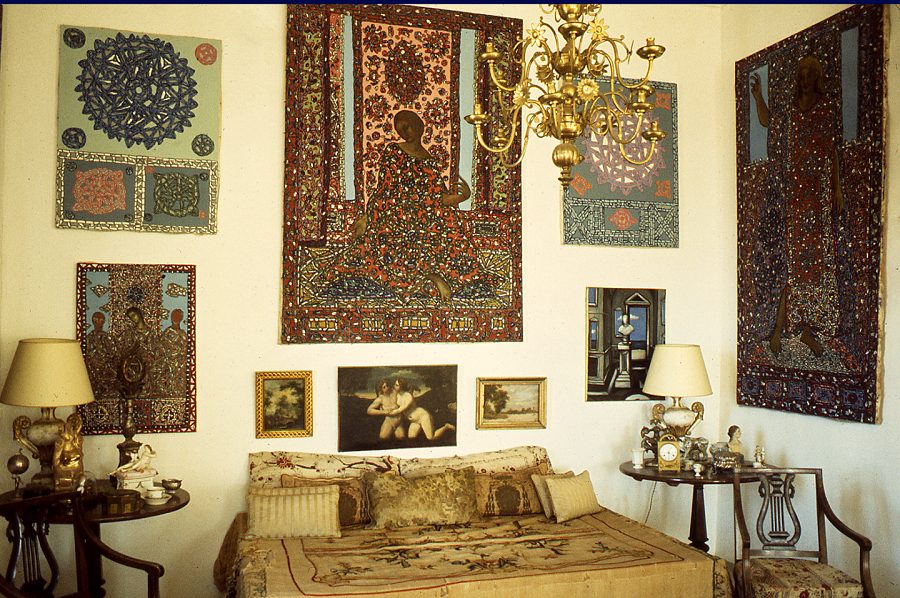
1975 interior Timothy painted on Yannis paintings when he was travelling somewhere, Photo: Bjørn Saastad
In 1949, Yiannis Latsis, future shipping tycoon, starts a regular boat service between the Argosaronic Gulf and the mainland with his famed Neraida; international travel becomes faster and more frequent, commercial aviation takes off and more effective infrastructure is continuously being developed. By the end of the Fifties, life on Hydra remains cheap and continues to attract young artists. Demetri Gassoumis arrives from San Francisco, as do Harry Jacobson and Sturges Mower, Norris Embry arrives from Chicago via Italy, Norman Peterson, Jane Motley, Sam Fischer, Brice and Helen Marden, Stephen Mueller visit from the United States, Marios Loizides – Cypriot national – crosses over from Rafina, Brenda Chamberlain moves from her isolated Welsh island to the Greek island, Robert Owen and William Pownall travel from Australia, Anthony Kingmill from Great Britain, Marcella Maltais from Canada, as do many others from different parts of the world including France, Norway and Germany. Americans and French follow in the wake of Henry Miller, Canadians of Leonard Cohen, Australians of Johnston and Clift. What starts as a European tour often ends in permanent stay. Income is hard to come by and regular travel to European city centers is a must to trade one’s wares, to publish a book, hang a show, promote a song, execute a commission, organize a performance, or take up a teaching assignment. Every day, foreign residents and locals alike look out for the boat to arrive; the foreigners expecting pending payments for their creative output, the locals to get paid – through those payments – for long outstanding bills.
Residents keep to themselves and enjoy large outdoor terraces that look out over the sea. The stone mansions, austere from the outside, hide impressive interiors with attention to luxurious details, beautifully laid stone floors, finely latticed wooden ceilings, metalwork, wooden doors and staircases. Furniture has been imported by ship from France and Italy and this mixture of sheer force with an elegant touch, softened by the use of embroidered fabrics, is typical of the Hydriot style. Days are filled with early morning and late afternoon swims, socializing around the port, working at home, and meeting with friends for a meal. Life is pleasant and languid with few modern amenities. Pavlos Pantelakis, who, in 1963, succeeded Periklis Vyzantios as director of the School of Fine Arts, is even more passionate about the preservation of the island and can be regularly seen with binoculars watching hawk-eyed any alterations, constructions or extensions.
The locals are friendly and tolerant but the differences in educational and cultural background, the language barriers, the adherence to a traditional, religious lifestyle with little or no interest in art, strengthen the distance between the two social groups. The wealthy Athenians who are increasingly interested in investing in the island, are equally conservative and set in their bourgeois ways, and disapprove of the bohemian mindset of the foreign community. Occasionally groups mingle, at the local tavernas, sharing a coffee, ouzo or a game of backgammon in the port, tending to the ever-growing yachts moored at the dock, skippering, attending parties or dancing together at the sophisticated Lagoudera night club.
Brenda Chamberlain, Welsh writer and artist, who spent a few years on Bardsey Island off the coast of Britain, where the weather lashes out and the tiny population is withdrawn and suspicious, discovers Hydra in the early Sixties and moves there until the arrival of the Junta. Disapproving of the glamorous life around the port, she withdraws high up on the hill and occasionally to one of the monasteries where she observes local life, whilst uttering sharp criticism at the habits and ambitions of her fellow international residents. Equally sharp in observation is the Greek novelist, Margarita Karapanou, who is sensitive to the underlying tension on the island. Both women talk about an undercurrent of violence, describe a murder, blame the oppressive heat, the desire and impossibility to escape and the pretense of posing as artists. Rumours are heard about excessive drinking, drug use and promiscuous behavior among the foreign community, putting at risk those with families, but also about self-discipline, routine and hard work.
As Hydra progresses so does the rest of the world and the island is far from isolated. Regular contact with the mainland, international travel and contact with visitors from abroad ensure full awareness of political, economic and cultural developments. The counterculture that has its roots in the Fifties with the beat poets – many of whom visited Hydra, including Allan Ginsberg, Gregory Corso and Harry Norse – gives way to the Summer of Love in 1967 and the hippie movement. The Cold War reigns and democracy is on the defensive, having to constantly define itself in between totalitarian regimes both left and right and social liberation movements.
Life on the island is sweet and artists are less inclined to large gestures. The intricate patterns of the main town are grappled through linear sometimes cubist drawings that trace the forms of the houses. The celebrated Mediterranean light, so intense in Hydra, leads artists to bring out all contours and outlines, colours and patterns, stimulating a realistic style, a decorative or stylized approach or a technique of assembled flat surfaces. Others watch the light dissolve every shape into patches without definable edges or into fields of monochrome color. Patterns appear in the zigzagged wall that runs down the western edge of town or in the twisting movements of the hydrea. Decorative patterns are sourced from further afield, historically, geographically and psychologically, from Byzantine and Eastern culture, philosophy and religion, and psychedelic experiences. John Craxton strings the flattened picture planes from a Byzantine aesthetic together as in mosaic art; Timothy Hennessy and Ioannis Kardamatis, inspired by the classic heritage as carried over by Byzantine art into the Renaissance, create a splendid interior like a Gesamtskunstwerk, with ornamental textiles, taints of gold and iconic figures; Brice Marden’s interlaces bands of color, executed with a technique influenced by Chinese calligraphy; Jane Motley embroiders every morning a small mantala, a ritual symbol that originates in the Hindu and Buddhist practices of meditation.
There is the global and there is the local. Norris Embry looks around him in the taverna and the kafeneion to the painted ceramics on the walls or on the tables translating the imagery with expressionist strokes into mixed media works that combine mask like faces, words and other elements into a footprint of the artist’s life. Scrabbling into notebooks, he observes life and restlessly fills page after page with carnivalesque, sometimes nightmarish drawings and anecdotal single objects like a coffee cup.
There is the inside and there is the outside. Community members gather around the tables in the harbour or the backstage tavernas to fraternize but work needs to be done at home or in the serenity of their studio where silence prevails. Demetri Gassoumis owns a spacious, professionally equipped studio with a large window for light that allows him to create large scale works such as folding screens, stencils for wall paintings, theater sets and interior fixtures. French artist Guy Allain, on the contrary, merges living space and studio into one multifunctional cluttered space housed in an old stable. Adam Shapiro, who buys a small house high up on the hill, prefers to work outside, repeatedly painting the same valley in view, situated on the road from Kamini to Vlychos. Most impressions of living and working arrangements come through old photographs but Angelika Freitag records the more intimate details in her India inspired miniature etchings and watercolors.
Works are scattered in private homes and many of the original residents have passed away. An exhibition and catalogue therefore are long overdue to hold on to that momentum when the small Greek island of Hydra was a bohemian paradise.
In the meantime, a new generation has taken roots, Tom Powell, Panagiotis Rappas, Alexis Veroucas, Jill Appert and many others, and new international artistic projects have been initiated such as DESTE’s Slaughterhouse and Hydra School Projects, proving the lasting charm of Hydra as an artistic magnet. And although tourism has changed the community, during the winter one can still find many a day when serenity reigns, the streets are empty, nature is at rest, and the air breathes mysticism and expectation.

